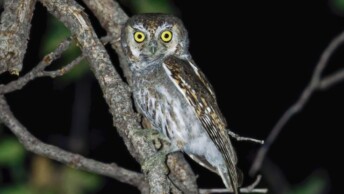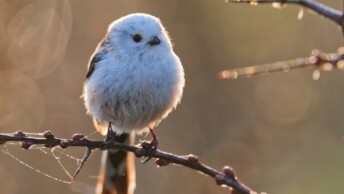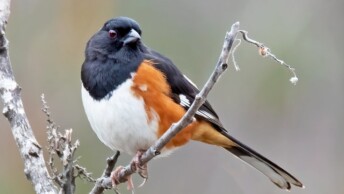Swans are the largest members of the waterfowl family Anatidae, a small but distinctive group of just six living species in the genus Cygnus. Found across Europe, Asia, North and South America, and Australia, they inhabit lakes, rivers, marshes, and coastal wetlands. While some, like the mute swan, have adapted to life alongside humans, others remain tied to wild northern tundras or remote southern waterways. Their size and stately presence make swans among the most iconic waterbirds in the world.
Mute Swan
Cygnus olor
- Identification: Very large white swan with a long S-curved neck, orange bill topped by a black basal knob, and a relatively long, pointed tail.
- Where found: Native across much of Europe and temperate Asia; widely introduced and established in North America on the Atlantic Coast, Great Lakes, parts of the Pacific Northwest and California; favors medium to large lakes, slow rivers, lagoons, estuaries, and urban park waters.
- How to spot: Look for the S-shaped neck and “busking” posture with wings arched over the back; in flight, listen for the rhythmic humming of the wings and note the extended head and neck.
- Conservation status: Least Concern globally; in North America a widespread nonnative managed in some areas due to displacement of native waterbirds and damage to aquatic vegetation.
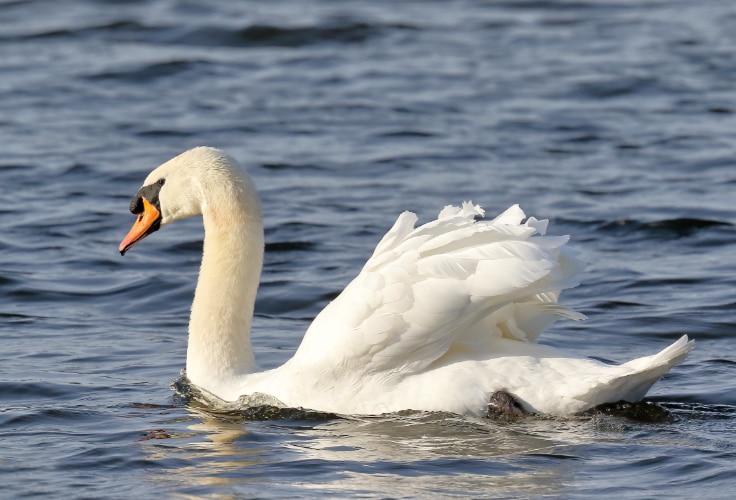
The mute swan is the world’s most familiar swan, often living alongside people on park ponds and sheltered waters. It is among the world’s largest flying birds, with adults measuring 127 to 152 centimeters (50.0 to 59.8 inches) in length and having a wingspan up to 2.38 meters (7.8 feet). Key structural cues include the long curved neck, comparatively long, pointed tail, and an orange bill capped by a black knob that is more prominent in adult males, especially during breeding.
Adults are entirely white, though the head and neck may show orange-brown staining from iron-rich waters. The bill is orange to reddish-orange with a black nail and black lores, and the legs range from slate-gray to black (some white-morph birds show grayish-pink). Sexes look similar, with males averaging larger and showing a larger knob. Juveniles are gray-brown or, more rarely, all white; gray birds gradually molt to white through the first winter, and all lack the adult bill knob until the second year.
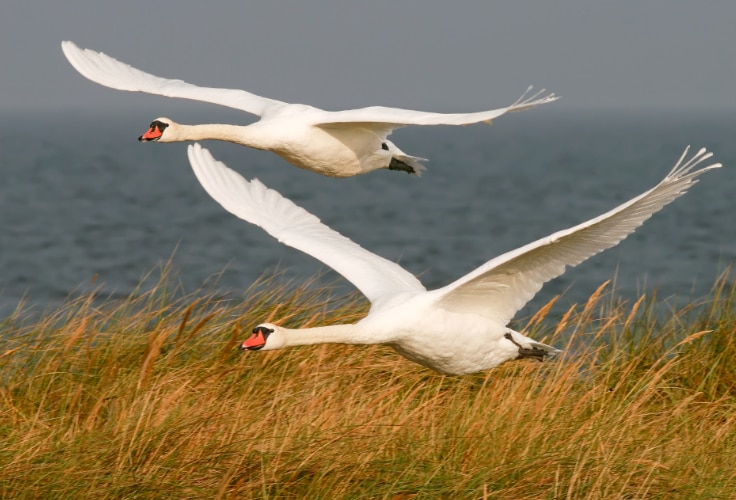
In the field, mute swans are conspicuous and often approachable. On water they commonly hold the neck in an elegant “S” and may raise the wings in a “busking” display during territorial encounters. They swim strongly, avoid fast flows, and can dive briefly to escape threats. In flight they take off with a long running start and fly with head and neck extended; the steady, audible hum of the wings can carry a long distance. Calls include low grunts and snorts and forceful hisses in threat displays. The diet is primarily aquatic plants and macroalgae taken by dabbling, dipping, and upending with opportunistic animal items taken in some situations.
Native breeding populations extend across the British Isles and much of continental Europe into western Russia and parts of Central and East Asia, with movements largely dictated by the availability of ice-free water. The species has been widely introduced outside its native range. In North America, established populations occur along the northeastern Atlantic Coast (from Massachusetts southward into the Mid-Atlantic), around the Great Lakes (including southern Ontario and adjacent U.S. states), locally in the upper Midwest, on southeastern Vancouver Island, and in parts of central and northern California. They inhabit lowland lakes, slow rivers, marshy lagoons, estuaries, reservoirs, gravel pits, canals, and ornamental park ponds. Nests are bulky mounds placed close to water with ample vegetation and ready access to foraging areas.
Globally the species is secure and in many regions increasing or stable, aided by its adaptability to human-modified waters. In North America, however, feral populations can depress native waterbird communities by aggressively displacing species and overgrazing aquatic vegetation. Managers in some states and flyways have employed control measures such as egg addling and culling, sometimes controversially, to protect habitats and to support recovery of native swans and sensitive marsh birds. Continued management focuses on limiting ecological impacts while maintaining safe coexistence where populations are established.
Trumpeter Swan
Cygnus buccinator
- Identification: Largest swan, entirely white with an all-black bill and legs; long straight culmen and wedge-shaped bill base distinguish it from tundra swan.
- Where found: Breeds in wetlands of Alaska, western and central Canada, and parts of the northern United States; winters on ice-free rivers, lakes, and coastal bays across the Pacific Northwest, interior West, and scattered sites farther south and east.
- How to spot: Look for its immense size, straight bill profile, and lower flight posture; powerful trumpeting calls are loud and resonant, unlike the softer whistles of Tundra Swan.
- Conservation status: Least Concern globally; a conservation success story in North America, where populations rebounded from near extinction but remain vulnerable to habitat loss, disturbance, and lead poisoning.
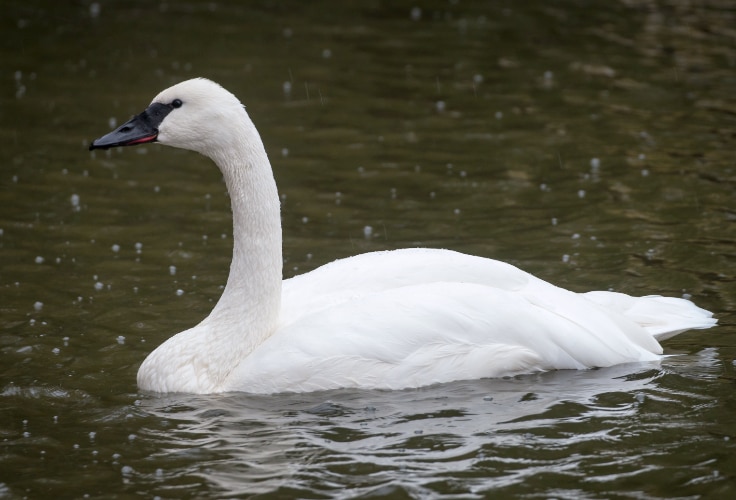
The trumpeter swan is the world’s largest waterfowl and the heaviest bird in North America. Adults can reach 183 centimeters (72 inches) in length, weigh up to 17.2 kilograms (38 pounds), and have a wingspan of up to 3.1 meters (10.2 feet). Their immense size, all-black bill, and long neck carried straight or slightly curved set them apart from other swans. Once nearly extirpated from the continental United States, intensive restoration efforts have returned the species to much of its historic range.
Adults are pure white, though the head and neck often appear rusty from foraging in iron-rich waters. The bill and legs are black, with some individuals showing a faint reddish streak along the lower mandible edge. Juveniles are dusky gray to brown, becoming whiter as they mature during their second year. Cygnets hatch covered in gray or, more rarely, white down. Males and females look alike, though males are generally larger.
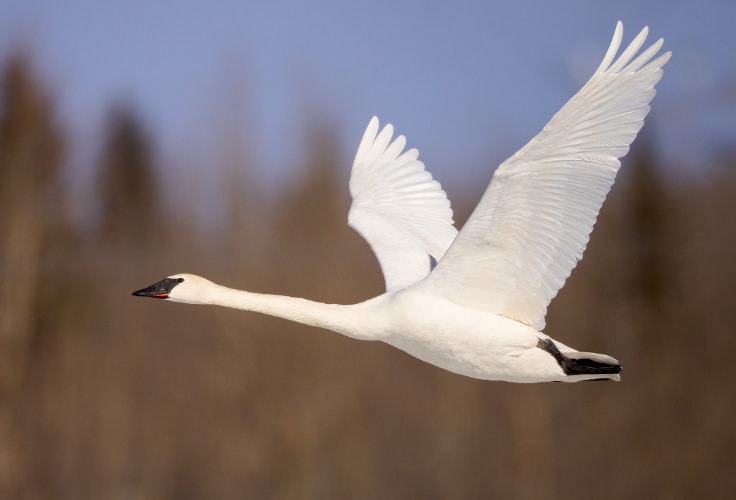
In the field, trumpeter swans are striking for their size and distinctive calls. The deep, resonant trumpeting notes carry long distances and help distinguish them from the higher-pitched whistles of tundra swans. In flight, they beat their wings rapidly and often travel in pairs or family groups, typically flying lower than geese and ducks. On the water they feed by dipping, upending, or digging with their bills and feet to uproot aquatic plants, and they readily forage in crop stubble and pastures in winter. Their diet is largely herbivorous, consisting of pondweeds, algae, grasses, and tubers, with occasional small animal matter.
Breeding occurs in wetlands, lakes, marshes, and slow rivers across Alaska, western and central Canada, and increasingly the northern United States from the Pacific Northwest through the Great Lakes. They build large mound nests in shallow water or on small islands with easy access to aquatic vegetation. Wintering sites are concentrated in southern Alaska, British Columbia, and the Pacific Northwest, with additional populations in the interior Rockies, Great Lakes, and scattered southern states where open water persists. Many restored flocks remain partly sedentary, while others migrate short distances to ice-free waters.
Once reduced to only a handful of birds in the early 20th century due to overhunting for meat, skins, and feathers, the trumpeter swan has rebounded dramatically thanks to legal protection, reintroduction, and habitat management. Populations are now increasing across three major regions: Pacific Coast, Rocky Mountain, and Interior. Despite its success, the species remains sensitive to disturbance at breeding sites and faces ongoing threats from lead poisoning, collisions with power lines, habitat loss, and illegal shooting. Continued protection of wetlands and careful management remain essential.
Tundra Swan
Cygnus columbianus
- Identification: Medium-sized white swan with an elegant long neck, black bill and legs, and a small yellow spot near the eye in most adults.
- Where found: Breeds on Arctic tundra across Alaska, northern Canada, and Siberia; winters on both coasts of the U.S., in the Great Lakes, and in Eurasia.
- How to spot: Look for flocks flying in V-formation with necks stretched straight out; distinguished from trumpeter swan by smaller size, shallower bill profile, and higher-pitched, bugling voice.
- Conservation status: Least Concern globally; the most numerous swan in North America, though vulnerable to lead poisoning, habitat loss, and disease outbreaks.
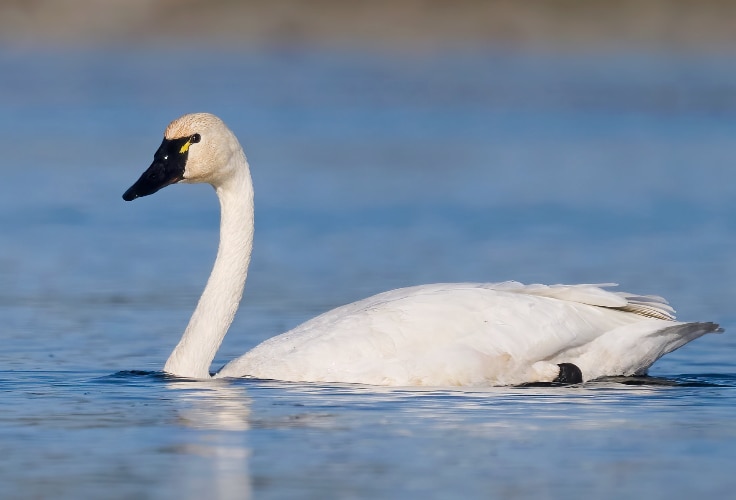
The tundra swan is the most abundant swan species in North America, breeding across the Arctic and migrating south each winter in vast, noisy flocks. Adults measure 120 to 150 centimeters (47.2 to 59.1 inches) in length, with a wingspan up to about 2.1 meters (6.9 feet). Slighter and shorter-necked than the trumpeter swan, it is best recognized by its all-black bill, often marked with a small yellow spot in front of the eye.
Adults are entirely white, while juveniles are pale gray-brown with pinkish-gray bills that darken during the first year. By spring, young birds are mostly white with only a few dusky feathers remaining. Males and females are similar, though males average slightly larger. The species occurs in two main forms: the whistling swan (C. c. columbianus), which breeds in North America, and the Bewick’s swan (C. c. bewickii) of Eurasia. Whistling swans are slightly larger with little or no yellow on the bill, while Bewick’s swans are smaller and show a more extensive yellow patch that usually extends back toward the nostrils.
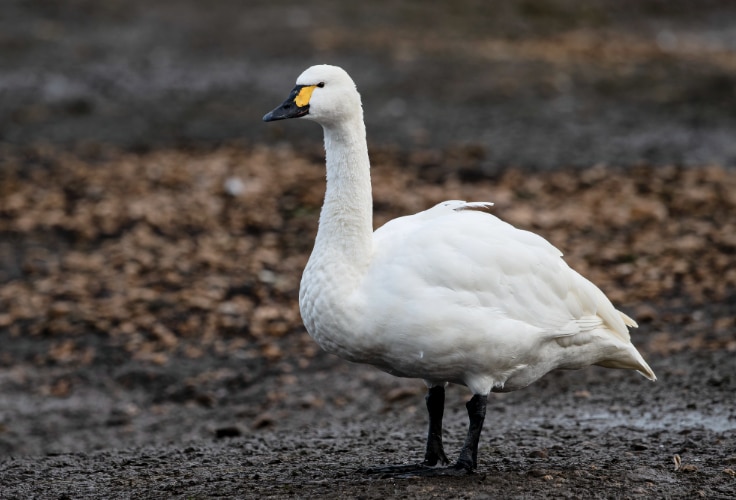
In the field, tundra swans are conspicuous and highly vocal. Their calls are high-pitched bugling or whooping notes, reminiscent of a Canada goose but less harsh than those of trumpeter swans. In flight they extend their necks straight forward, trailing black legs, and their wingbeats lack the mechanical humming of mute swans. They forage by dipping or upending in shallow water for pondweeds, grasses, and roots, and they also graze in fields of corn, grain, or winter wheat. Along the mid-Atlantic coast, they dig for clams and other aquatic invertebrates, sometimes competing with gulls.
The breeding range spans Arctic Alaska, northern Canada, and Siberia, where pairs nest near tundra lakes, ponds, and river deltas. In North America, two major populations migrate south: the Western Population winters from British Columbia and the Pacific Northwest into California’s Central Valley, while the Eastern Population winters along the Atlantic coast from New Jersey to the Carolinas, with smaller numbers inland on the Great Lakes and occasionally farther south. In Eurasia, Bewick’s Swan breeds from the Kola Peninsula east across Siberia and winters mainly in northwestern Europe and East Asia. Nests are built on raised ground near water, often on ridges or islands that provide visibility and access to food.
Although still abundant and considered secure, tundra swans face significant threats. In North America they are subject to regulated hunting seasons, and mortality also results from lead poisoning caused by ingested fishing tackle and spent shot, as well as collisions with power lines. Avian cholera and parasitic infections have caused die-offs, especially in staging areas such as the Chesapeake Bay. Habitat loss from wetland drainage and energy development in Arctic breeding grounds and key stopover sites poses ongoing risks. Continued management and habitat protection will be crucial to maintain the health of this widespread and iconic swan.
Whooper Swan
Cygnus cygnus
- Identification: Very large white swan with a straight neck, black legs, and a long bill marked with an extensive pointed yellow patch at the base.
- Where found: Breeds across Iceland, Scandinavia, and northern Russia to eastern Siberia; winters in western and central Europe, around the Black and Caspian Seas, and in East Asia as far as China, Korea, and Japan. Rare winter visitor to Alaska and the Pacific Northwest.
- How to spot: Look for its upright stance, long neck, and large yellow-and-black bill; calls are loud, bugling whoops that carry over long distances.
- Conservation status: Least Concern globally; secure overall but facing pressures from wetland loss, agriculture, and collisions with power lines and wind turbines.
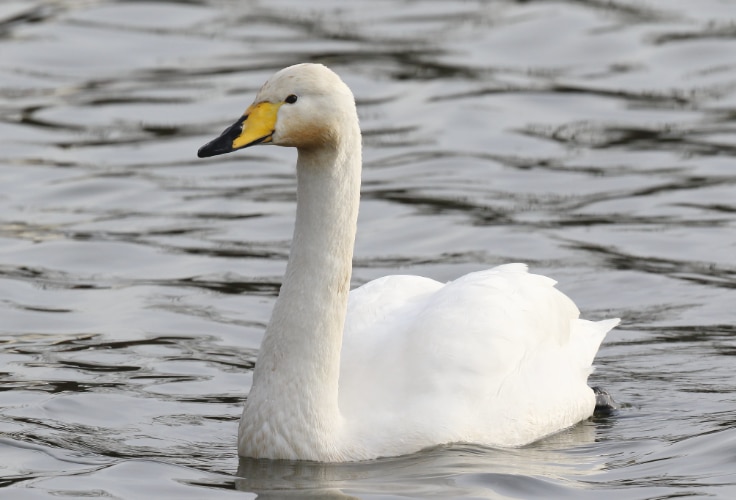
The whooper swan is the Eurasian counterpart to North America’s trumpeter and tundra swans. Adults measure 140 to 165 centimeters (55.1 to 65.0 inches) in length with wingspans reaching up to 2.75 meters (9.0 feet). Their sheer size, upright bearing, and bold yellow-and-black bill make them distinctive. Occasionally, small numbers reach Alaska and the Aleutians, where they are notable as rare vagrants.
Adults are pure white, though the head and neck can show rusty staining from iron-rich waters. The bill is black with a large triangular yellow patch extending beyond the nostrils, larger and more pointed than in tundra swans. Juveniles are grayish with pinkish or whitish bases to the bill, becoming white during their first spring. Males and females are similar, with females slightly smaller.
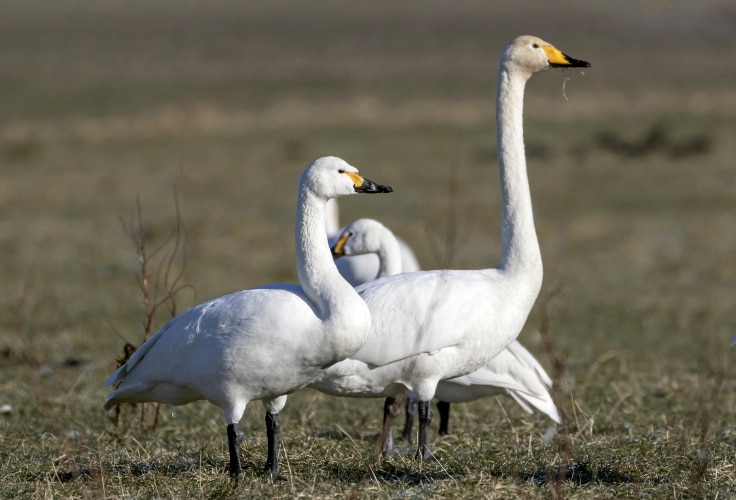
In the field, whooper swans are recognized by their resonant bugling calls, deeper and harsher than the musical notes of tundra swans. They migrate in V-formations and feed by dipping or upending in shallow water, grazing on pastures, or digging for tubers in farmland. Their diet is mainly vegetarian, including pondweeds, eelgrass, grasses, and crops like potatoes and grain, but they also take invertebrates and mussels in some areas. In winter they often forage in agricultural fields, and in East Asia they regularly feed in rice paddies.
The breeding range extends from Iceland and northern Scandinavia across northern Russia to Siberia, where pairs nest near lakes, pools, and rivers in open or wooded country. Icelandic birds winter mostly in Britain and Ireland, while continental populations spread across Europe, the Black and Caspian Sea basins, and into East Asia, particularly Japan, Korea, and China. Migratory journeys can be long but are typically made at low altitudes, with some individuals covering 1,600 to 4,000 kilometers (1,000 to 2,500 miles) in spring migrations.
The species is numerous and widely distributed, but its habitats face many pressures. Wetland drainage for agriculture and irrigation, overgrazing, vegetation cutting, and infrastructure projects affect breeding and stopover sites. Collisions with power lines and wind turbines, oil spills, lead poisoning, and hunting also pose risks. Despite these threats, global populations remain stable, and the whooper swan continues to thrive across much of its vast range, remaining one of the most familiar and iconic wild swans of Eurasia.
Black Swan
Cygnus atratus
- Identification: Striking large swan almost entirely black with bright red bill and white wing feathers visible in flight.
- Where found: Native to Australia and Tasmania; widely introduced and established in New Zealand, with small feral populations elsewhere. Found on large lakes, lagoons, estuaries, and flooded fields.
- How to spot: Look for the all-black plumage, long S-shaped neck, and red bill; in flight shows broad white panels across the wings.
- Conservation status: Least Concern globally; abundant in Australia and New Zealand, though affected locally by wetland drainage, human disturbance, and crop conflicts.
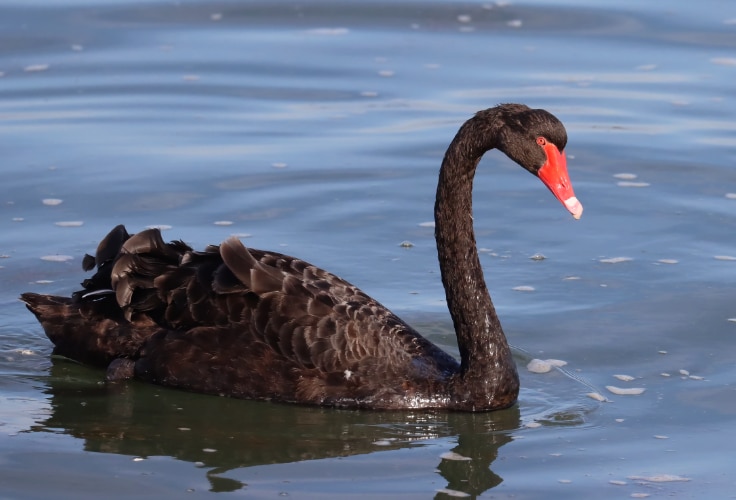
The black swan is one of the world’s most distinctive waterfowl, instantly recognizable for its unusual dark plumage. Adults measure 110 to 140 centimeters (43.3 to 55.1 inches) in length and have wingspans reaching up to 2 meters (6.6 feet). It is unique among swans in being almost entirely black, with white primary and secondary feathers that flash conspicuously during flight. Its red bill and reddish to pinkish eyes add further contrast, and females average slightly smaller with less vivid bill coloration.
Juveniles are dark gray-brown with mottled plumage and pale-tipped feathers, gradually becoming black as they mature. The species is unmistakable when seen well, though its all-dark form contrasts strongly with the white swans of the Northern Hemisphere.
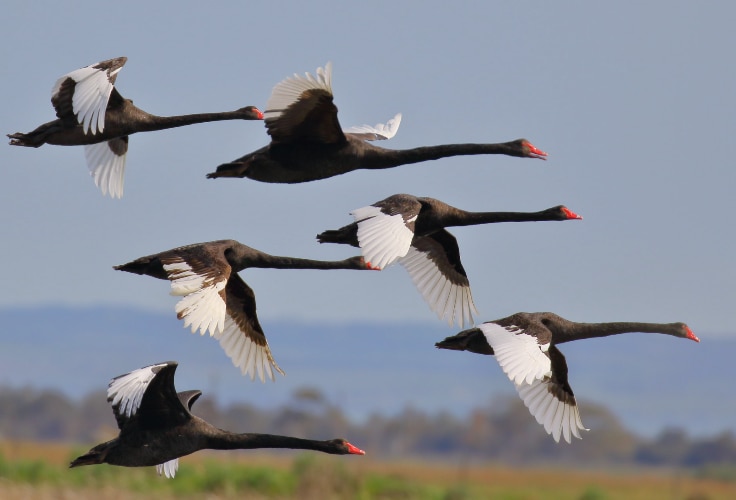
In the field, black swans are conspicuous on water, often swimming in loose flocks or family groups. Their voices are higher-pitched and more musical than those of other swans, consisting of soft bugling notes, whistles, and conversational calls, along with loud hisses in defense. Wingbeats produce a whistling sound in flight. They feed by dipping, dabbling, and upending in shallow waters, consuming mainly aquatic plants, algae, and pondweeds, but they also graze on pasture grasses and crop fields. In New Zealand, they often forage in estuaries on eelgrass and can gather in huge flocks during molt or on favored lakes.
Native to Australia and Tasmania, the black swan inhabits lakes, lagoons, slow rivers, billabongs, estuaries, and even artificial waterbodies such as reservoirs and sewage ponds. It has been introduced to New Zealand, where it is now widespread and common, and small feral populations occur in parts of Europe. During droughts, birds may move nomadically in search of water, and in some regions they form massive concentrations numbering in the tens of thousands. Nesting occurs on islands or in reedbeds, with large mounds of vegetation built near open water.
The species is abundant and secure, protected both legally and culturally in Australia. Numbers are stable overall, though local declines may occur from habitat loss, wetland drainage, or food shortages following storms. In agricultural regions, crop damage has led to some culling, particularly in southeastern Australia and Tasmania. In New Zealand, populations surged after introduction in the 19th century, peaking in the mid-20th century before stabilizing at lower but healthy levels. With its distinctive appearance and cultural significance, the black swan remains one of the most iconic waterbirds of the Southern Hemisphere.
Black-Necked Swan
Cygnus melancoryphus
- Identification: Medium-sized swan with white body plumage, contrasting black neck and head, and a bright red knob at the base of the bill.
- Where found: Native to southern South America, from southern Brazil and Uruguay through Chile and Argentina to Tierra del Fuego and the Falkland Islands.
- How to spot: Look for its black neck and head set against a white body, with a red knob on the bill; often seen in groups on lakes, lagoons, and estuaries.
- Conservation status: Least Concern globally; widespread and generally common, though vulnerable to wetland loss, hunting, and collisions with power lines.
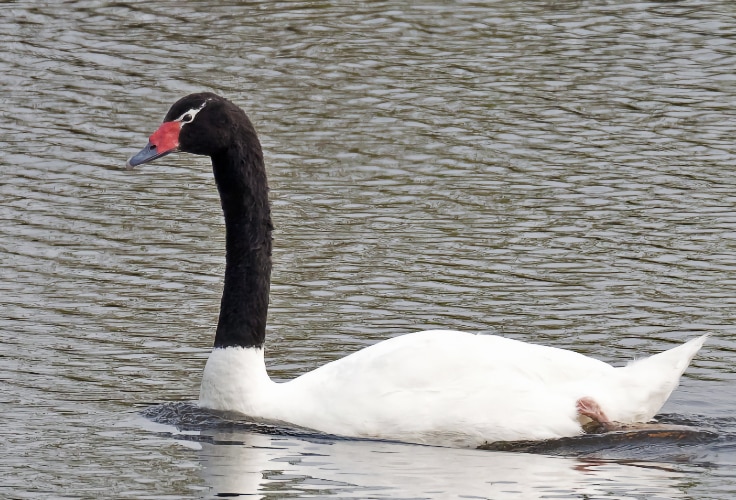
The black-necked swan is the only true swan of the Neotropics and a striking sight across southern South America. Adults measure 102 to 124 centimeters (40.2 to 48.8 inches) in length with a wingspan up to 1.77 meters (5.8 feet). Their unique combination of white body, velvety black neck and head, and bright red bill knob makes them unmistakable.
Juveniles resemble adults in pattern but are much duller, with grayish-brown body plumage and dusky gray necks; the red knob develops gradually and is not fully formed until three to four years of age. A narrow white stripe behind the eye is variably present in adults, sometimes absent altogether.
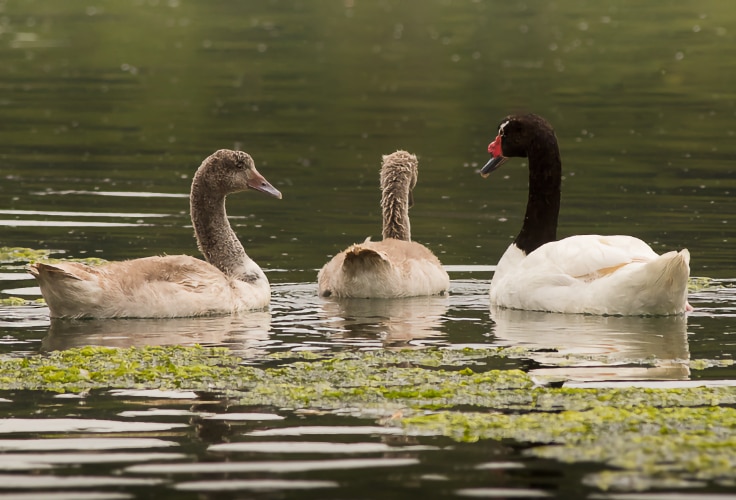
In the field, black-necked swans are mostly silent, but pairs and families exchange soft musical whistles or wheezy “whee-whee-whee” calls, and males sometimes give a deeper, bugling “hooee-hoo-hoo.” Their wingbeats can whistle in flight. They forage mainly by dipping or upending in shallow water, feeding on pondweeds, stoneworts, eelgrass, and algae, occasionally grazing in fields during droughts. They may form large flocks outside the breeding season, with gatherings of thousands recorded in Argentina, Uruguay, and Chile.
The breeding range extends from Tierra del Fuego and the Falklands north to central Chile, Uruguay, and southern Brazil. Birds nest in reedbeds, marshes, and lagoons with abundant aquatic vegetation, building large mounds of plant matter near or on the water. While populations in the Falklands and northern parts of the range are largely resident, those breeding at higher latitudes move northward in winter, sometimes reaching as far as São Paulo. During years of drought or El Niño events, birds shift extensively between wetlands, occasionally wandering to sub-Antarctic islands and even the Antarctic Peninsula.
Black-necked swans are widespread and generally numerous, with major concentrations reported at sites such as Laguna de Chascomús in Argentina and Bañados del Este in Uruguay. Legal protections and wetland reserves have helped populations recover in places where they were once heavily hunted for skins and eggs. Today, threats include wetland drainage, collisions with power lines, and occasional disturbance or egg collection, though the species remains secure overall. With its bold plumage and gregarious habits, it is one of the most characteristic waterfowl of South America.
Swans and Their Diversity
Although the world has only a handful of swan species, they show striking differences in ecology, temperament, and relationship with people. Some, like the mute swan, thrive in human-dominated landscapes, paddling on park ponds and fiercely defending territories where they nest. Their size, lifelong pair bonds, and sometimes aggressive defense of cygnets make them both familiar and formidable neighbors.
Others, such as the trumpeter or whooper swan, remain tied to vast wilderness, their haunting calls echoing across northern marshes and tundra. Even the more localized black-necked swan of South America and the black swan of Australia reflect the diversity of habitats swans occupy worldwide.
Whether close to people or far removed from them, swans remain enduring symbols of grace and strength – large, long-lived birds whose loyalty to partners and families underscores their place as some of the most iconic waterfowl on the planet.

